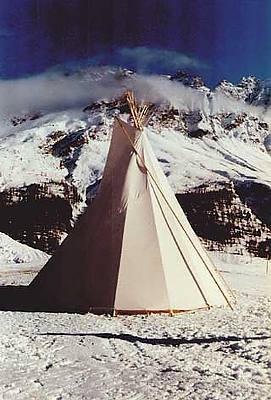Materials
 After many years of experimentation, FAM WEST tents are now made of cotton-based fabrics, which in our experience hold up best in the toughest summer and winter camps. Cotton is also extremely good value for money compared to other natural fabrics. We are continuously gathering feedback at events throughout Europe and keep in touch with our customers. Both the selection of fabrics and the construction of individual tents are the result of long development.
After many years of experimentation, FAM WEST tents are now made of cotton-based fabrics, which in our experience hold up best in the toughest summer and winter camps. Cotton is also extremely good value for money compared to other natural fabrics. We are continuously gathering feedback at events throughout Europe and keep in touch with our customers. Both the selection of fabrics and the construction of individual tents are the result of long development.
All of our fabrics are waterproofed and treated against mould.
At the moment three different cotton fabrics are available:
Standard tent cloth 300 gr/m² natural color + 12 basic colors (as available)
This tent cloth is especially appropriate for summer camps since the tents are light enough to be set up by almost anyone. (Anyone who has set up a 6m tepee or a medium sized medieval pavillion made of thick cloth knows what I'm talking about!) In addition, the tents of this cloth are lighter to store and to transport. With good care these tents can last more than 10 seasons. The price of 300gsm cloth is also highly competitive.
Strong tent cloth 360 gr/m² natural color
A resistant cloth, scuff and tear proof. This cloth is recommended for camps which remain up continuously from spring to late fall. Because of its strength it is especially water and wind resistant and perfectly designed for long-term use. For those who are relying on the long-lasting durability of the cloth, and who want cotton, this 360 gr/m² is just the right thing!!
Extra strong tent cloth 420 gr/m² natural color
Mixed weave 50/50 cotton+polyester
An absolute must for those who have their tents up year round and who want to enjoy the wonderful atmosphere of a tent in winter as well. Extremely tightly woven and well waterproofed, this material holds up to the worst storms, downpours, frost or heat like no other. If you are planning a tepee village or medieval camp which is to be permanent, there's no better material. Especially suitable for year-round use and winter camping. Note however that the inclusion of some synthetic material will preclude the use of this fabric by some re-enactment groups.
A few words about "life span":
The way canvas is looked after and handled will be the single most important determinant of how long a tent lasts. Even the word tent is a little misleading in connection with our products. The Indians' tents and the medieval pavillions were much more than just a sheltered place for their inhabitants to sleep in. They were the living, dining and workrooms, as well as serving as a school, town hall or church. They were a place for living. These mobile habitations of the past were treated accordingly. A tent was a high cost possession and its proud owners lovingly cared for it. Many Indians believe that the round shape of the home had special power, and that since they gave up that way of life, this power has diminished. "There is no power in square houses".
Our tents have a soul and each should be taken care of.
 The World of period
The World of period  please wait...
please wait...